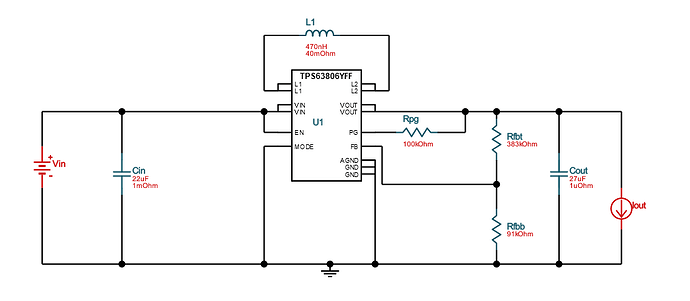Yeah by also depleting the cap from 3V to 1V maybe 50% more standlight can be gained. Probably easier to use a 50% bigger supercap. Enough theory let us see some pictures of your work already! ![]()
I finally made few pictures, they are on the original post here :
For the standlight, I think a TPS6980X (X being 2, 5, 6 or 7). TI webench gives me this design
Anyone knows where the PCBs can be found ?
Apart from standard evaluation boards, which are not really compact and totally overpriced for the private user, the only option might be to design your own boards (e.g. with KiCAD) and produce them with JLCPCB (<10 Euro incl. tax shipping… for 5 boards).
Hmmm… I think such a “normal” voltage regulator could be even better than an “LED” regulator. If one sets the output to 2.7V or so the standlight should be bright enough. On top of that, while cycling the LED runs with >2.7V anyways… in that case the regulator should not provide any standlight current until the LED voltage drops <2.7V? So with a “normal” voltage regulator and the right output voltage standlight should only fire at very low speeds and when standing still. No further “stand still detection” needed?
Thank you quadrupel
Yeah, evaluation boards are crazy expensive… I thought about JLCPCB, I will have to dig into pcb design eheh
You certainly have a great idea here, and I will process it as it could simplify the whole thing. I fail to understand exactly what will happen at very low speeds, with the superC already charged.
I guess the regulator will still be running, while the “main string” will also feed some current into the standlight led, thus replacing a little bit of the regulator’s work…
EDIT : I made a typo in a message above, it’s not a tps639xxx but tps638xx, and most likely the tps69802 (or 63020)
Are you sure that the regulator will stop providing current when driving ? I mean, if you force the regulator output to be higher than what it is set for.
I thought you were referring to the output overvoltage protection, but it triggers at almost 6V…
Hi there,
I continued my research and found this
It looks like I underestimated how bad driving a led with voltage actually is. At approx 2.7V, the current through the led would vary from 80 mA at 20° to more than 350 mA at 120°.
Well, the led will never heat that much since it will be in a metal casing (3 cm diameter and length cylinder), and it will be driven at 500 mA max while driving.
But still, it will vastly depend on ambiant temperature. I will have to test the whole thing to see how hot it will get…
Otherwise I could use a variable resistor to tune the regulator voltage, and change it twice a year for winter…
